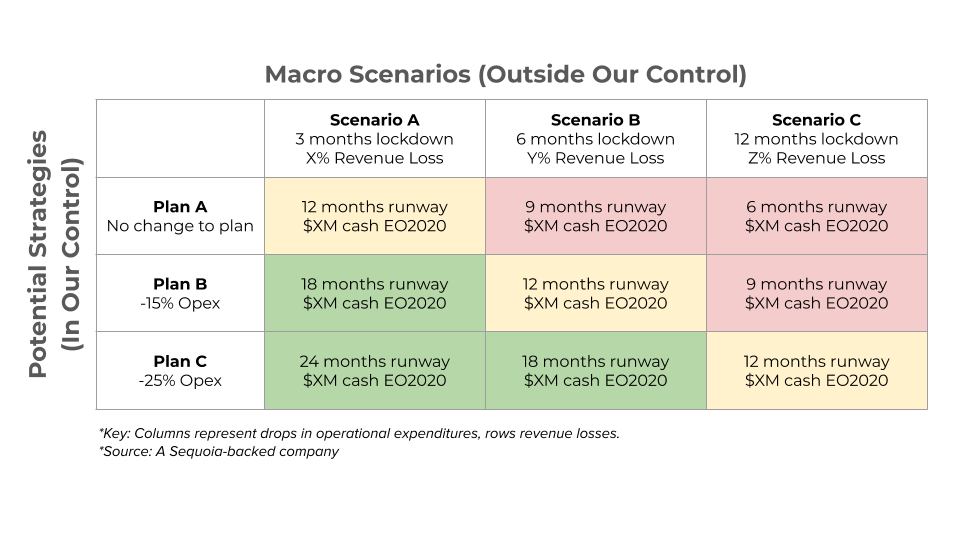The economy is in doldrums, and businesses are reeling from it. To stay afloat, most businesses have initiated cash conservation measures. Salary costs are a significant component of company expenditure. Sooner than later, companies get down to salary cuts or deferments to manage their payables.
Here’s a simple 5-step process guide that can help you navigate the choppy waters of pay cuts.
1. Determine How Much To Cut
It’s heartening to see the big consulting firms sharing advice and best practices with their Covid19 Resource Centers. The Covid-19 Matrix by Sequoia is quite helpful in scenario planning, at least for funded companies.
To begin, you need to model various scenarios from the optimistic to the worst case. Doing this will help you understand what cost-cutting measures are needed to balance your cash-flows. After this exercise, you have a precise number in mind: "I need to reduce 20% of my salary costs".

2. Arrive At The Pay Cut Policy
If you know how much salary costs to prune, the most straightforward policy is to do an across the board, uniform cut. If your target is a 20% reduction, do a salary cut of 20% for every employee.
However, this is not a fair policy. Most companies come up with a tiered plan where the lower-income group is less impacted, and the highest income group carries the most burden.
In this step, you want to decide on the various salary bands and how much burden you will place on each group to attain the overall target reduction.
For example, if your overall salary cost is two crores and you want to implement a 20% salary cut, you may end up with a policy like this:

3. Choose The Cost Reduction Instrument
There are at least three ways in which you can implement the salary expense reduction. It depends on your scenario planning and your estimate about how fast the situation will recover. Will it improve in 2 to 5 months, or will it be for the long haul?
- Permanent Pay Cut: If you predict a long-term impact on business and receivables, it's better to implement a permanent pay cut. You will consider salary revision only when the situation improves for the business.
- Salary Deferment: If you have temporary cash-flow issues and hope to recover your receivables, you can go for a salary deferment. You will pay back employees once your account receivables improve.
- Temporary Cut: If there is no hope of recouping revenue losses even after the situation improves, this is the right way of balancing your cash flows.
4. Communicate With Your Employees
Taking care of your employees and extensively communicating with them is critical at this time. Keep employees informed, no matter how difficult or unpleasant the news might be. They will appreciate it and empathize with these decisions.
It's equally important to inform the employees about the pay cuts well in advance and then keep them posted when a decision is taken.
It's best to do the salary cuts based on a standard policy since it is easy to communicate. If you choose to do ad-hoc salary cuts customized to each employee, you will need to deliver the information individually. This method not only has significant overheads but is less transparent as well.
5. Execute The Policy In Payroll
Based on the pay-cut policy arrived at in step 2, you need to determine the quantum of salary deduction for each employee.
Once you have a list of employees and the amount of salary to be cut for each of them, you need to make changes to the payroll. There are a few different ways in which you can make the salary deduction. There are a few concerns to keep in mind:
- If this is a temporary cut or deferment, you may want to avoid impacting statutory deductions like PF & ESI. If you touch these, it may lead to hassles.
- When you deduct the amount from the gross salary, you may be deducting excess income tax. During these times, you want more money in the hands of employees after salary cuts.
- You may wish to keep track of the deductions so that you can reverse them at a later date.
Be sure to check out our upcoming blog entry that deals with this topic in depth.
Bonus Tip: Use The Right Tool
While Excel spreadsheets are commonly used, a purpose-built application makes life easier. Salary revision planning with the latest employee data can get done in minutes instead of hours. With payroll software, it's also simpler to implement your salary plan and process the payroll. Besides, it's a lot easier to communicate the changes to the employees through the payslips or the Employee Portal.
More work on the way up
The salary cuts are in response to the slowdown and help you manage cash-flows. When the situation starts improving, you will need to reverse some of these decisions. While the process is almost the same as above, the specifics will vary a little. There is more work on the way up.









